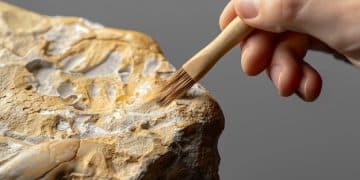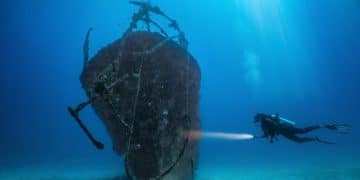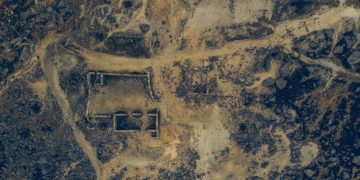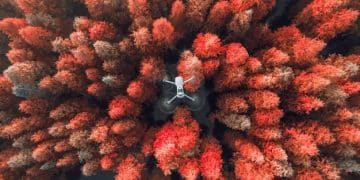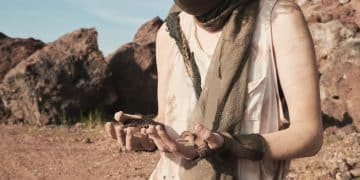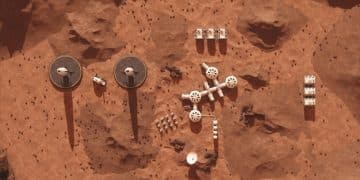Citizen Science in US Archaeology: Unearthing Discoveries
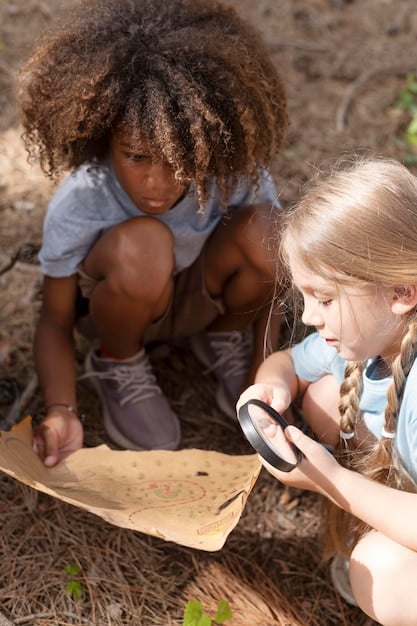
Citizen science in archaeology, driven by dedicated volunteers, is revolutionizing how significant discoveries are made across the US, offering invaluable support to professional research and enhancing public engagement with historical sites.
In the vast tapestry of American history, layers of untold stories lie buried beneath our feet, waiting to be unearthed. The sheer scale of archaeological potential across the United States is immense, far exceeding the capacity of professional archaeologists alone. This is where the role of citizen science in archaeology: how volunteers are contributing to important discoveries across the US, truly shines, transforming dedicated enthusiasts into invaluable partners in the quest to understand our shared past.
The Rise of Citizen Archaeology: A Collaborative Endeavor
Citizen science, a dynamic collaboration between everyday individuals and professional researchers, has experienced a remarkable surge in popularity across various scientific disciplines. In archaeology, this collaborative approach is not merely a trend but a transformative force, blurring the lines between the academic elite and the passionately curious public. Volunteers, often with no formal archaeological training, are proving to be indispensable assets, bringing fresh perspectives, vast numbers, and unwavering dedication to the field.
The concept itself is rooted in a long tradition of public involvement in historical preservation and discovery. From amateur historians documenting local landmarks to artifact collectors sharing their findings, the public has always played a role. However, modern citizen science initiatives are structured, often led by universities, museums, or governmental agencies, ensuring rigorous methodology and ethical standards are maintained.
From Casual Interest to Scientific Contribution
What motivates individuals to donate their time and effort to dusty dig sites or meticulous lab work? The appeal is multifaceted. For many, it’s the thrill of discovery, the direct connection to history that few other activities offer. Others are driven by a desire to contribute to scientific knowledge, to be part of something larger than themselves. Furthermore, these programs offer unique educational opportunities, allowing participants to learn directly from experts and acquire practical archaeological skills.
The structured nature of contemporary citizen science programs ensures that volunteer contributions are not only enthusiastic but also scientifically valid. Training sessions cover everything from proper excavation techniques and artifact identification to data recording and ethical considerations. This commitment to education empowers volunteers, turning them from mere helpers into genuinely informed and effective researchers.
The impact of this collaboration extends beyond the specific discoveries. Citizen science fosters a deeper appreciation for heritage conservation and encourages public stewardship of archaeological sites. It bridges the gap between academic institutions and the communities they serve, making archaeology more accessible and relatable to a broader audience.
This section has explored the foundational aspects of citizen science in archaeology, highlighting its growth and the diverse motivations driving volunteer participation, all while emphasizing the structured frameworks that ensure scientific rigor and ethical practice.
Unearthing History: Diverse Volunteer Contributions Across the US
The contributions of citizen scientists span a wide spectrum of archaeological activities, from initial site identification to the meticulous post-excavation analysis that transforms raw data into historical narratives. Their involvement extends the reach of archaeological research far beyond what professional teams could achieve alone, bringing diverse skills and localized knowledge to the forefront.
On-Site Excavation and Survey
Perhaps the most iconic image of archaeological work involves digging, and citizen scientists are actively engaged in countless excavations nationwide. These volunteers participate in systematic surveys, often walking vast tracts of land to identify potential archaeological sites through surface finds or topographical anomalies. Once a site is identified, they assist in regulated excavations, patiently sifting soil, identifying features, and meticulously recording their findings.
- Site Identification: Volunteers conduct systematic surveys, often using GPS and mapping tools, to locate previously undiscovered archaeological sites.
- Excavation Assistance: Under professional supervision, they meticulously excavate, documenting stratigraphy and recovering artifacts with care.
- Artifact Recovery: They are trained to identify, clean, and bag artifacts, ensuring proper chain of custody and preservation.
- Data Recording: Precise record-keeping, including photography, measurements, and field notes, is a critical volunteer task.
Beyond the physical labor, volunteers often possess invaluable local knowledge, having grown up in the areas they are researching. This intimate familiarity with the landscape, local lore, and informal historical records can provide crucial context and lead researchers to sites that might otherwise remain hidden.
Laboratory Work and Analysis
The archaeological process doesn’t end in the field. A significant portion of the work occurs in laboratories, where artifacts are cleaned, cataloged, conserved, and analyzed. Citizen scientists play a vital role in these often labor-intensive tasks, contributing significantly to the understanding of excavated materials.
Volunteers assist with the precise cleaning of delicate artifacts, a process that requires patience and steady hands. They help in the meticulous cataloging of every recovered item, assigning unique identifiers and entering data into comprehensive databases. This data entry is crucial for future research and helps establish the provenance of artifacts.
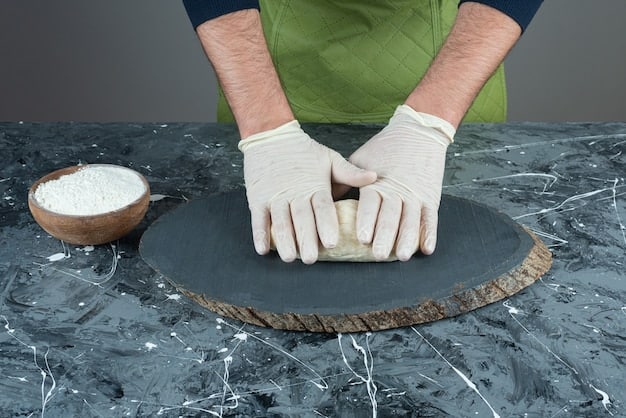
Furthermore, some programs train volunteers in more specialized analytical techniques, such as basic faunal or floral identification, or even initial ceramic typology. While not replacing the expertise of trained specialists, their assistance frees up professional time, allowing for deeper, more complex analyses to be conducted. This broad participation ensures that the massive volume of data generated by excavations is processed efficiently and effectively.
From the dusty field to the controlled environment of the laboratory, the diverse contributions of citizen scientists are undeniably crucial to the breadth and depth of archaeological understanding across the United States. Their dedication directly facilitates the transformation of raw finds into historical insights.
Notable Discoveries and Their Volunteer Backbones
The impact of citizen science in US archaeology is not merely theoretical; it is evidenced by a growing list of significant discoveries that would have been impossible or severely delayed without volunteer involvement. These case studies highlight the tangible outcomes of integrating community participation into archaeological research.
One compelling example comes from the realm of historical archaeology, specifically concerning battlefields and early American settlements. The American Battlefield Trust, a non-profit organization dedicated to preserving America’s battlefields, frequently engages volunteers in their archaeological initiatives. These citizen archaeologists assist in locating battle lines, identifying troop movements through artifact distribution, and understanding the daily lives of soldiers and civilians. Their methodical surveys have led to the precise mapping of previously vague skirmish sites and the discovery of artifacts like musket balls, uniform buttons, and camp remnants, offering new insights into pivotal historical events across states like Virginia, Pennsylvania, and Georgia.
Prehistoric Site Investigations
Discoveries related to prehistoric Indigenous cultures have also greatly benefited from citizen science. In the Southwest, for instance, projects involving the Bureau of Land Management and local universities often invite volunteers to participate in surveying vast tracts of land for ancient Puebloan or Mogollon settlements. These surveys are crucial in identifying rock shelters, early agricultural features, and pottery scatters that indicate long-term human occupation. Volunteers in Utah, working on projects exploring Ice Age megafauna and early human migrations, have helped uncover pristine sites with evidence dating back thousands of years, pushing back the timeline of human presence in North America.
Another area where volunteers have shined is the identification and protection of fragile rock art sites. Many such sites are located in remote areas, making them difficult for professional teams to monitor regularly. Citizen scientists, often hikers or local residents, are trained to document and report new findings or potential damage, acting as invaluable stewards of these irreplaceable cultural resources across states like Nevada, Arizona, and California. Their ongoing vigilance contributes significantly to the preservation of these ancient artistic expressions.
These examples illustrate a fundamental truth: the sheer scale of the archaeological landscape in the US necessitates a broad base of involvement. Volunteer efforts extend the reach of archaeology into remote areas, provide continuous monitoring, and accelerate the processing of monumental amounts of data, leading directly to a richer, more nuanced understanding of America’s multifaceted past.
Training and Ethical Considerations in Citizen Archaeology
While the enthusiasm of citizen scientists is a powerful asset, it must be harnessed responsibly. Rigorous training and a strong emphasis on ethical conduct are paramount to ensure that volunteer contributions are not only valuable but also preserve the integrity of archaeological sites and findings. The archaeological record is fragile and non-renewable, making responsible practice non-negotiable.
Preparing Volunteers for Field and Lab
Reputable citizen science programs invest considerably in training their volunteers. This training typically covers several key areas:
- Basic archaeological principles: Understanding stratigraphy, context, and the importance of scientific method.
- Field techniques: Proper excavation methods, use of tools, mapping, and GPS data collection.
- Artifact handling and identification: Safely recovering, cleaning, and basic classification of materials.
- Data recording: Meticulous note-taking, sketching, photography, and site form completion.
- Safety protocols: Ensuring the well-being of all participants in often challenging environments.
This systematic approach ensures that volunteers understand the “why” behind the techniques, not just the “how.” Many programs offer tiered training, allowing volunteers to advance from basic tasks to more complex responsibilities as they gain experience and demonstrate proficiency. This structured learning environment fosters a sense of professionalism and commitment among participants.
Moreover, the training often emphasizes the interdisciplinary nature of archaeology, introducing volunteers to concepts from geology, anthropology, and even forensic science, enriching their overall understanding of the discipline.
Navigating Ethical Landscapes
Ethical considerations form the cornerstone of any legitimate archaeological endeavor, and citizen science is no exception. Volunteers are educated on the profound importance of site preservation and the illegality and destructiveness of “pot-hunting” or collecting artifacts outside of sanctioned research.
Key ethical principles instilled in volunteers include:
- Non-disturbance: Understanding that digging or removing artifacts without authorization destroys irreplaceable context.
- Respect for cultural heritage: Recognizing that archaeological sites, especially those of Indigenous peoples, hold deep cultural significance.
- Data integrity: The importance of accurate and unbiased recording to ensure scientific rigor.
- Confidentiality: Protecting sensitive site locations from those who might seek to loot or damage them.
By embedding these ethical guidelines within their training programs, project leaders empower citizen scientists to act as responsible stewards of cultural heritage. This proactive approach ensures that amateur involvement genuinely enhances, rather than inadvertently harms, the valuable archaeological record across the US. The cultivation of an ethical mindset is as crucial as the technical skills imparted.
Challenges and Opportunities for Growth
While the benefits of citizen science in archaeology are undeniable, the model is not without its challenges. Addressing these issues is crucial for sustained growth and for maximizing the impact of volunteer contributions. Simultaneously, there are immense opportunities to expand the reach and effectiveness of these programs, shaping the future of archaeological research in the US.
Overcoming Obstacles
One persistent challenge lies in funding. While volunteers provide free labor, projects still require resources for equipment, professional oversight, laboratory analysis, and curation of artifacts. Securing consistent grants and financial support for citizen science initiatives remains a hurdle for many organizations.
Quality control is another critical aspect. Despite rigorous training, ensuring consistent data quality across a large, diverse volunteer base can be difficult. Professional archaeologists must dedicate significant time to supervising, cross-checking, and verifying volunteer work, which can sometimes strain limited resources. Moreover, maintaining long-term engagement can be a challenge; while many volunteers are highly dedicated, projects often experience turnover, requiring continuous recruitment and training.
Logistical complexities also arise, particularly with remote sites. Transporting volunteers and equipment to distant locations, managing diverse schedules, and ensuring safety in varying environments require careful planning and coordination. Finally, public perception can sometimes be a barrier, with some still viewing archaeology as an exclusive academic pursuit, unaware of the significant role everyday citizens can play.
Forging Ahead: A Path for Expansion
The opportunities for growth, however, are just as compelling. Technology offers exciting new avenues for expansion. Mobile apps can facilitate broader participation in remote sensing and site reporting. Online platforms can enable virtual laboratory work, allowing volunteers to classify artifacts from digital images or transcribe historical documents from anywhere in the world. This democratizes access and lowers geographical barriers to participation.
Building stronger partnerships is another key opportunity. Collaborations between academic institutions, governmental agencies (like the National Park Service or state historical societies), and local community groups can create more robust and sustainable programs. Integrating citizen science into K-12 education curricula could also foster a newfound appreciation for archaeology among younger generations, potentially cultivating future archaeologists and ensuring long-term public engagement.
Targeted recruitment strategies could help diversify the volunteer pool, bringing in individuals with specialized skills, such as GIS mapping expertise, photographic abilities, or linguistic knowledge valuable for archival research. By embracing innovation, fostering strong partnerships, and continuously adapting to new technologies, citizen science in archaeology is poised for significant expansion, cementing its role as a vital component of historical inquiry across the US. Addressing these challenges head-on will pave the way for even greater discoveries and broader public engagement.
Ultimately, the continued success of citizen archaeology rests on recognizing its value, fostering robust training protocols, and strategically seeking new avenues for participation and funding. The journey is ongoing, but the potential is immense.
The Future of Volunteer-Driven Archaeology
As we look to the horizon, the trajectory of citizen science in archaeology suggests an increasingly integrated and essential role for volunteers. The intersection of emerging technologies, enhanced collaboration models, and a growing public appetite for meaningful engagement heralds a promising future where archaeological discovery becomes an even more collective endeavor. The evolution of this field is inextricably linked to how effectively we can leverage the unique strengths of a dedicated and diverse volunteer base.
Technological Integration and Accessibility
Future advancements will likely see an even greater integration of digital tools. Imagine AI-powered platforms assisting volunteers in preliminary artifact identification from high-resolution images, or augmented reality apps guiding them through site mapping with unprecedented precision. Drones equipped with LiDAR and other remote sensing capabilities, operated by trained citizen scientists, could rapidly survey vast and previously inaccessible areas, identifying subtle anomalies indicative of buried structures or features. This technological shift will not only make archaeological work more efficient but also more accessible to individuals with varying physical abilities or geographical constraints, allowing for participation from anywhere with an internet connection.
The rise of digital curation and online databases will also revolutionize how volunteer-collected data is managed and utilized. Centralized, searchable repositories can make archaeological findings more accessible to researchers globally, fostering interdisciplinary studies and opening new avenues for interpretation. This shift from purely physical participation to hybrid models incorporating virtual contributions will empower a broader demographic of citizen scientists to contribute to invaluable research.
Broader Public Engagement and Education
The future also holds the potential for citizen archaeology to become a more integral part of public education and cultural heritage preservation. Programs that weave archaeological discovery into school curricula or offer accessible workshops to diverse community groups can ignite an early passion for history and stewardship. This proactive engagement helps cultivate a generation that understands and values the importance of protecting archaeological sites.
A more robust emphasis on storytelling, where volunteers are not just contributors but also narrators of the past, can bridge the gap between academic findings and public understanding. This can take the form of community exhibitions, digital stories, or interactive online platforms where volunteers share their experiences and the significance of their discoveries, making archaeology more relatable and inspiring. The focus will increasingly shift towards not just finding artifacts, but also effectively communicating their story and relevance to a wider audience.
Ultimately, the future of volunteer-driven archaeology is one of democratic participation, technological empowerment, and a shared commitment to unraveling the complexities of human history. As resources for traditional archaeological research remain constrained, the innovative and tireless spirit of citizen scientists will become even more indispensable, forging a powerful path for discovery across the United States. This symbiotic relationship promises to unlock untold stories and preserve our collective heritage for generations to come, transforming the landscape of archaeological pursuit.
| Key Contribution | Brief Description |
|---|---|
| 🗺️ Site Identification | Volunteers conduct surveys to locate and document potential archaeological sites. |
| ⛏️ Excavation & Recovery | Under supervision, they assist in careful digging, artifact recovery, and initial processing. |
| 🔬 Lab Analysis & Curation | They help clean, catalog, and prepare artifacts for further scientific study in laboratories. |
| 📚 Data Recording & Preservation | Meticulous documentation and adherence to ethical guidelines ensure site integrity and data accuracy. |
Frequently Asked Questions About Citizen Science in Archaeology
▼
Citizen science in archaeology involves non-professional volunteers actively participating in archaeological research, under the guidance of trained professionals. This can include field surveys, excavations, lab work, and data analysis. It aims to expand research capacity and deepen public engagement with historical preservation efforts, covering vast areas across the United States.
▼
Volunteers contribute in various ways: identifying new sites through surveys, assisting with systematic excavations, meticulously cleaning and cataloging artifacts in labs, and recording crucial data. Their sheer numbers and local knowledge significantly extend the reach of archaeological projects, leading to discoveries that might otherwise be missed or delayed due to limited professional resources.
▼
Participants typically receive comprehensive training covering basic archaeological principles, field techniques (e.g., excavation, mapping), artifact handling and identification, precise data recording methods, and essential safety protocols. This training ensures that their contributions are scientifically valid and adhere to ethical standards, protecting the integrity of archaeological sites and findings.
▼
Ethical considerations are paramount. Reputable programs heavily emphasize non-disturbance of sites, respect for cultural heritage (especially Indigenous sites), data integrity, and confidentiality of sensitive locations. Volunteers are educated about the illegality and destructiveness of unsanctioned artifact collection (“pot-hunting”) to ensure responsible and beneficial engagement with archaeological resources.
▼
The future looks promising, with increased integration of technology like AI and remote sensing, making participation more accessible. Stronger partnerships between academic institutions, government agencies, and communities are expected. Citizen science will continue to play a vital role in expanding archaeological research capacity, fostering public education, and preserving cultural heritage across the United States.
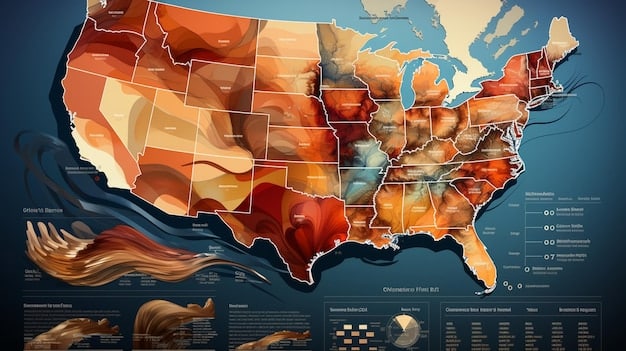
Forging a Shared Past Through Collaborative Discovery
The ongoing narrative of human history in the United States is one perpetually being rewritten and enriched by new discoveries. The invaluable contribution of citizen scientists stands as a testament to the power of collective effort in uncovering these stories. By bridging the gap between professional expertise and public passion, citizen archaeology not only accelerates the pace of discovery but also cultivates a widespread appreciation for the delicate and irreplaceable nature of our shared heritage. As technology evolves and collaborative models mature, the role of dedicated volunteers will only grow in significance, ensuring that the echoes of the past continue to resonate for generations to come.
